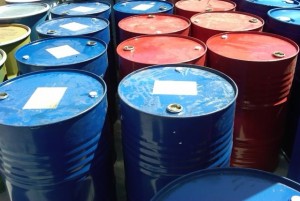 WTI crude rose back to positive daily territory after the Energy Information Administration reported a smaller-than-projected increase in U.S. crude inventories last week, while distillate fuel stockpiles fell by nearly 5 million barrels. Gains were however limited on speculations Iran and world major powers may reach an accord on the Islamic republics disputed nuclear program and as another Libyan terminal was reopened. Upbeat U.S. retail sales underpinned the market.
WTI crude rose back to positive daily territory after the Energy Information Administration reported a smaller-than-projected increase in U.S. crude inventories last week, while distillate fuel stockpiles fell by nearly 5 million barrels. Gains were however limited on speculations Iran and world major powers may reach an accord on the Islamic republics disputed nuclear program and as another Libyan terminal was reopened. Upbeat U.S. retail sales underpinned the market.
On the New York Mercantile Exchange, WTI crude for delivery in January traded at $94.25 per barrel at 16:00 GMT, up 0.38% on the day. Prices swung between gains and losses following a series of key U.S. economic data and shifted in a days range between $94.48 and $93.26 per barrel. The U.S. benchmark added 0.4% on Tuesday and extended its weekly advance to 0.6% following Wednesdays gains.
Meanwhile on the ICE, Brent futures for settlement in January rose by 0.61% to $107.58 per barrel by 16:01 GMT. The European benchmark held in range between $106.62 and $107.74 a barrel and trimmed its weekly decline less than 0.8% following Wednesdays advance.
Oil prices drew support after the Energy Information Administration reported a smaller-than-projected rise in U.S. crude inventories in the week ended November 15. The agency said that crude stockpiles rose by 0.4 million barrels to 388.5 million, the highest level since June, and were well above the upper limit of the average range for this time of the year. The gain however was smaller than a predicted 1 million barrel increase according to the median estimate of 11 analysts surveyed by Bloomberg.
Refineries operated at 88.6% of their operable capacity last week, down from 88.7% in the preceding period. U.S. crude oil imports averaged 7.9 million barrels per day, up by 19 000 barrels from a week earlier. Supplies at Cushing, Oklahoma, the biggest U.S. storage hub and delivery point for NYMEX-traded contracts, rose by 1.74 million barrels to the highest since July.
The report also showed that both motor gasoline and distillate fuel production decreased last week, averaging 9.3 and 4.9 million barrels per day, respectively. Motor gasoline inventories fell by 0.3 million barrels and matched analysts expectations, remaining above the upper limit of the average range for this time of the year. Distillate fuel stockpiles decreased by 4.8 million barrels last week, sharply exceeding projections for a drop of 280 000 barrels, and were near the lower limit of the average range. Total commercial petroleum inventories fell by 11.7 million barrels last week.
Phil Flynn, senior market analyst at the Price Futures Group in Chicago, commented for Bloomberg: “The inventory report is a bit supportive. The retail sales report is bullish for crude and it raises demand expectations.”
U.S. retail sales
Oil also drew support after a gauge of U.S. consumer spending rose more than expected in October, signaling the 16-day government shutdown had little to no effect on the economy and suggesting upside momentum early in the fourth quarter.
The U.S. Department of Labor reported that retail sales rose by 0.4% last month, exceeding the median estimate of 86 analysts surveyed by Bloomberg for a minor 0.1% advance. September’s reading received and upward revision to 0.0% after being initially estimated at -0.1%.
Meanwhile, core retail sales, which exclude the volatile automobile market, jumped by 0.2% last month after September’s reading was revised down to 0.3% from initially calculated at 0.4%. Core retail sales correspond closely with the consumer spending component of gross domestic product (GDP). Their jump was largely based on increased demand for clothing, electronics, furniture and sporting goods.
Sales at electronics and appliance stores rose by the most since April, while sales at automobile and parts dealers jumped by 1.3% after falling by 1.2% in the preceding month.
Libyan output improvement, Iran talks
Also fanning negative sentiment, Ibrahim Al Awami, the director of measurement for the Libyan oil ministry, said for Bloomberg that a tanker with capacity to carry around 600 000 barrels of oil was loading at the center-eastern Brega terminal and was scheduled to depart yesterday. This was the first loaded cargo in more than a month.
Prices were pressured on Tuesday as a spokesman for the state-run National Oil Corp. said the western Mellitah port was reopened after members of the Amazigh minority closed the complex last week. The terminal became operational on Saturday after protests ended, allowing the second-largest oilfield in western Libya, El Feel, to resume production.
Despite the recent improvement however, investors remained wary as the country continued to be shaken by ongoing protests and as most of its facilities remained shut.
Olivier Jakob, managing director at Petromatrix GmbH, said in a report, cited by Bloomberg: “Libya is still far from being at full output as it is still missing large volumes from Ras Lanuf and Es Sider but we count 3 million barrels of crude oil loadings this week and this is still a supply improvement, for now.”
Market players also awaited developments around the third round of talks between Iranian diplomats and their counterparts from the five permanent members of the U.N. Security Council and Germany.
A senior U.S. official hinted on Friday a deal with Iran was “quite possible” this week but U.S. Secretary of State John Kerry said on Monday he had no specific expectations about reaching an accord, providing some support to prices. If an agreement was to be struck, it would lift U.S. and EU sanctions on Iran’s oil exports, paving the way for the return of more than 1 million barrels of oil per day to the global market. The two sides reconvened in Geneva on Wednesday.





